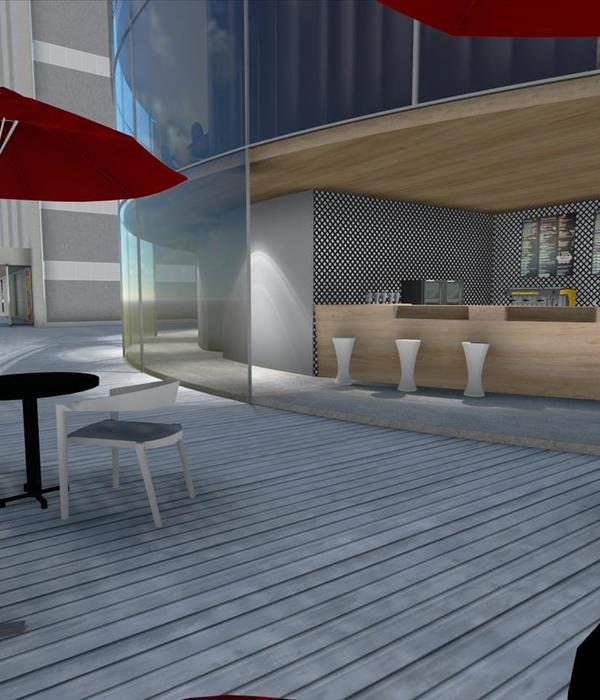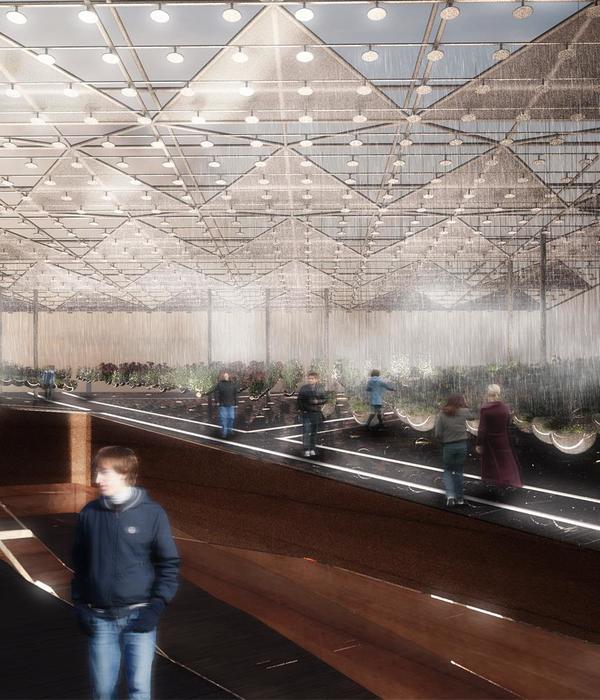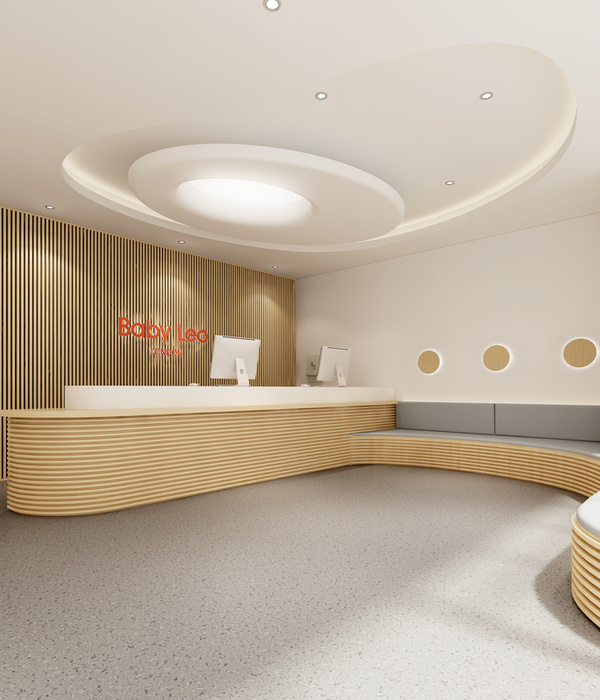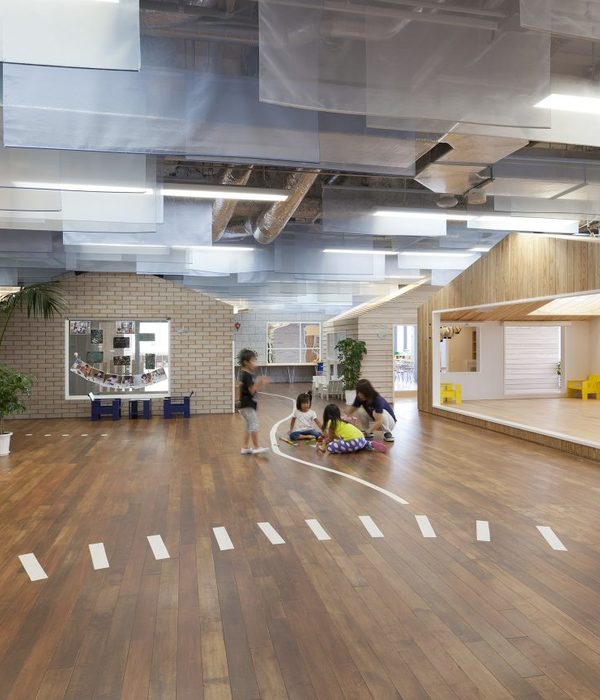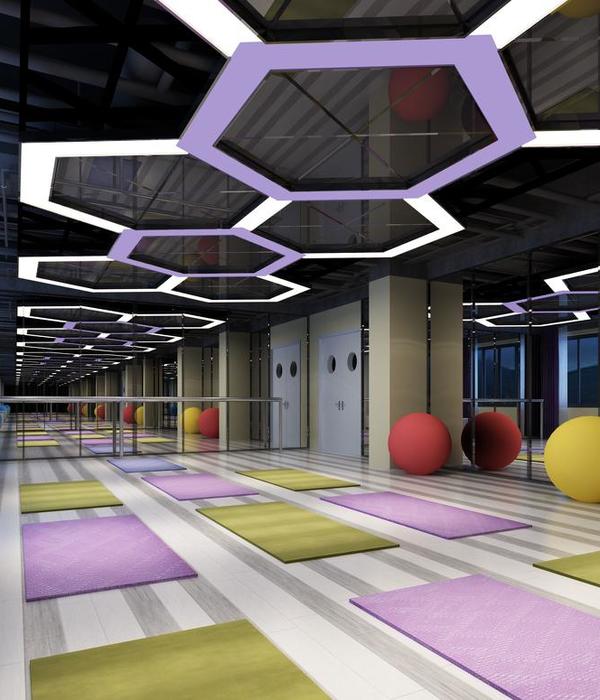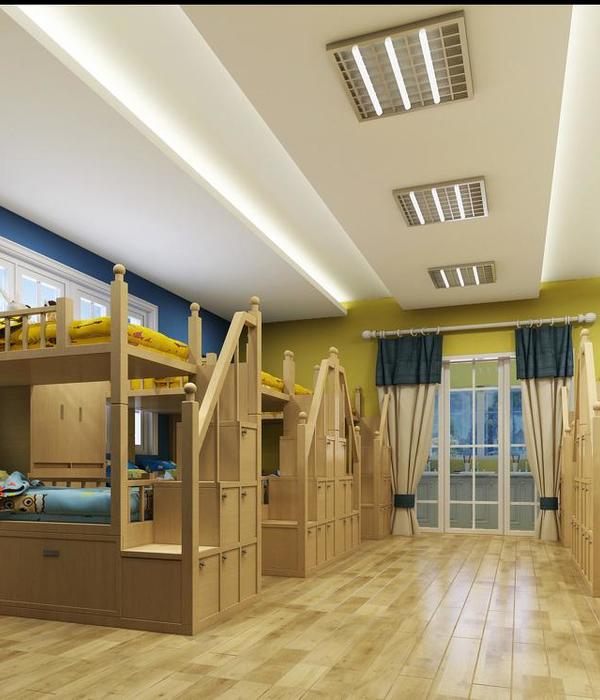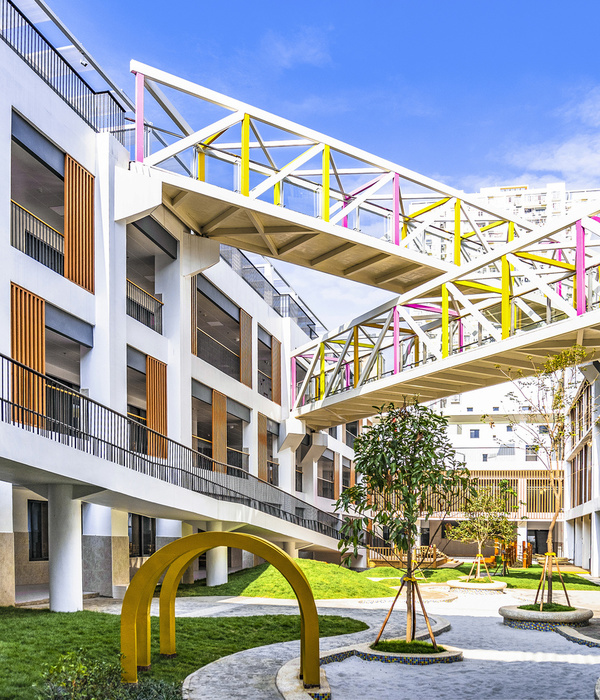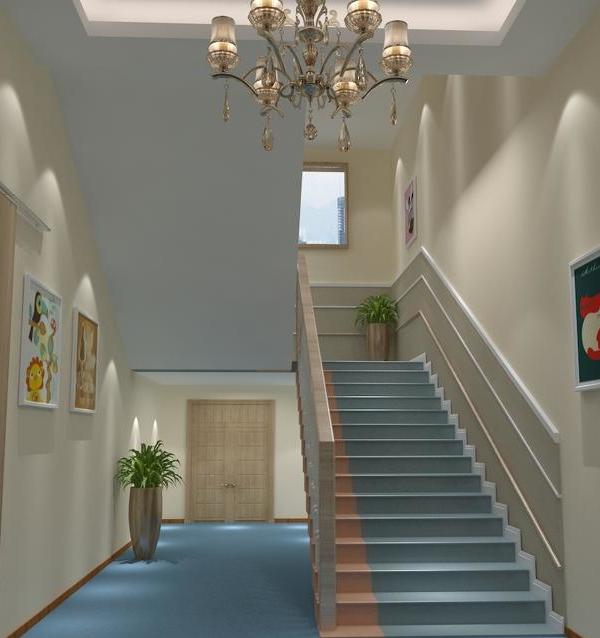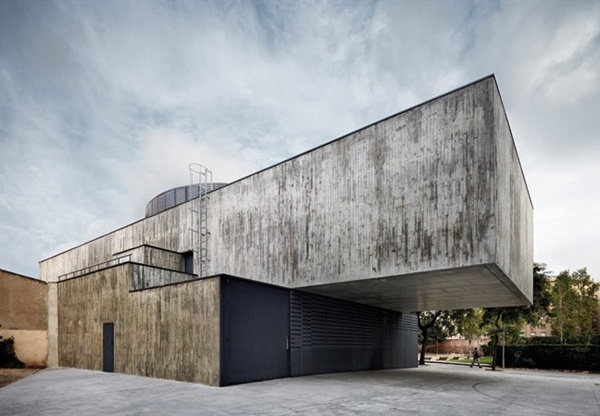本项目为2013年RIBA竞赛中的获胜方案,由Rogers Stirk Harbour + Partners设计,该方案以建筑的方式彰显出伦敦经济学院的价值。建成后的项目超额完成了英国建筑研究所环境评估法BREEAM优秀的评级,达成了“杰出”的成就,为学生与教师们提供了创新并鼓舞人心的教学空间,其中就包括一处范本式的新型“LES风格”演讲厅,项目的核心理念旨在鼓励并促进各学术部门之间的合作与交流。
The LSE Centre Building project was won by a RIBA competition in 2013 and presented Rogers Stirk Harbour + Partners (RSHP) with an opportunity to design a building to reflect the values of the London School of Economics and Political Science (LSE). The project has delivered their brief by exceeding the BREEAM Excellent target to achieve “Outstanding”, delivering innovative and inspirational teaching spaces including a new prototype ‘LSE style’ lecture theatre, and providing departmental space to encourage collaboration and dialogue between departments.
▼项目外观概览,Centre Building at the LSE ©Joas Souza
此外,RSHP事务所还在该方案中规划了一个极具功能性的全新公共广场,作为学校的中心来改善并连接校园中的交通流线。为了在场地中为公共广场留出足够的空间,本项目需要最大限度地利用场地上建筑的限制高度,最终,建筑的高度超过了最初设计的设想,由一组6层楼的体量与一个13层楼的体量两部分组成,楼层数量的设置参考了周围相邻建筑的高度。教学中心的每个立面都呼应了周围建筑环境的现有肌理,并根据霍顿街和新广场的不同空间质量,在立面材料的纹理与材质上做了相应的改变。
RSHP’s proposals also created a substantial new public square to improve wayfinding and connectivity by offering a much-needed focal point at the heart of the LSE campus. To accommodate the public square the buildings massing needed to maximize the height constraints of the site – by going higher than the brief had assumed, comprising of 6 and 13-storey interlocking volumes which relate to the height of the neighbouring buildings. The façade of each respond to the existing fabric, changing in grain and materiality to recognise the different spatial qualities of Houghton Street and the setting of the new square.
▼由建筑俯瞰广场,对面墙上为Tod Hanson的壁画《幽灵党》,View from level 1, looking down on the square with Tod Hanson’s mural, Spectre, on the opposite wall ©Joas Souza
建筑的设计秉承了可持续原则,达到了BREEAM“杰出”标准(88.9%),建筑的内部具有良好的采光,且室内自然通风占通风总量的70%以上。通过巧妙设计与精心的材料选择以及采用一系列生态措施,包括雨水收集、生物质锅炉以及太阳能光伏板等,建筑的隐含碳减少了30%。内部工作空间的设计旨在提高人们的幸福感,四处露台空间分别位于第三、七、十二层以及十二层的屋顶,这些露台空间不仅为员工和学生提供了充足的休闲场所,同时也为增加生物多样性做出了贡献。
Embracing sustainable design principles from the offset the BREEAM Outstanding (88.9%) building provides good daylighting throughout and natural ventilation to over 70% of the interior. The building’s embodied carbon was reduced through design and material selection by 30%, it harvests rainwater and utilises a biomass boiler and PVs. The internal workspaces are designed to enhance wellbeing with 4 terraces on levels 2,6, 11, 12 for staff and students providing both recreational space and increased biodiversity.
▼俯瞰顶层露台与生态花园,Looking down at the roof terraces on level 6 and level 12 ©Joas Souza
▼由屋顶露台看较高的建筑体量,Level 6 terrace ©Joas Souza
由于项目的场地坐落于校园的中心,且整个校园以步行线路为主,因此,场地上的建筑受到了诸多的限制,建筑内的后勤工作也相对复杂。为了应对这种情况,整栋建筑尽可能地采用了预制结构,这一点从建筑上部分的钢结构与预制空心板形成的框架结构中表现地尤为明显。预制的标准截面梁柱结构于现场由螺栓连接在一起,并暴露在内部空间中,最终形成独特的建筑外观与室内氛围。
The restricted nature of the site at the heart of a pedestrian campus made construction logistically complex. In response prefabrication was used wherever possible, evident in the steel superstructure and precast hollow core planks that form the structural frame. Composed of standard section columns and beams bolted together on site, expressed internally to give it a distinct appearance.
▼石材立面呼应了周边建筑的历史文脉, The stone rainscreen cladding responds to the context of The Old Building ©Rogers Stirk Harbour + Partners
北立面和南立面的外部支撑结构为建筑提供了水平方向上的稳定性。主要支撑结构呈交叉状,这种简洁的立面表达方式不仅独特而大胆,同时在结构选型上也是最经济而高效的,因为它最小化了构件的数量。十字支撑位于建筑的保温围护层之外,最大限度地提高内部空间的灵活性,同时避免了结构连接件与楼板之间的热桥效应。
▼结构分析图,structure analysis ©Rogers Stirk Harbour + Partners
The building’s external bracing on the northern and southern facades provides lateral stability to the building and is expressed as a distinctive, bold, and yet simple cross brace that is structurally efficient and economical in that it minimises the number of fabricated elements. The cross braces sit outside the thermal envelope of the building to maximise internal flexibility, therefore all structural connections back to the floor plates are thermally broken.
▼立面细部,Facade Louvre detail ©Joas Souza
▼遮阳百叶细部,Louvre detail ©Joas Souza
教学设施以及非正式的学习与创新空间位于较低建筑体量的首层至三层,由一部雕塑般的“学术楼梯”连接,该楼梯位于三层通高的中庭中,楼梯的尽头是景观平台,为学生们提供了休闲与观景的场所。
Teaching facilities and informal student learning and breakout spaces are accommodated between the lower ground and second floor, connected by a single sculptural “academic stair” which rises in a three-storey atrium terminating at a landscaped student terrace.
▼共享学习空间,Student Learning Commons ©Joas Souza
▼由首层共享空间看街道,viewing the street from the Student Learning Commons on the ground floor ©Joas Souza
▼学术楼梯与吸音板,Academic Stair with red acoustic baffles ©Joas Souza
▼中庭的学术楼梯,Academic Stair in the atrium ©Joas Souza
▼由三层看中庭与学术楼梯,Atrium viewed from the second floor ©Joas Souza
三层以上为学术部门,充足的学习空间以灵活的方式组织在一起,包括一系列可互换使用的研讨式与开放式办公空间。每两个楼层之间都设有一个二层通高的中庭,一条蜿蜒的楼梯贯穿了三层以上的楼层,将所有学习空间串联在一起,这种设置不仅鼓励并促进了各部门之间的合作交流,同时为建筑的立面增添了更为丰富的表达效果。
Above the second floor, academic departments are housed on flexible floor plates that provide a mixture of interchangeable cellular and open plan offices. These are connected by a meandering “collaborative” stair, in a series of double height voids designed to encourage interdepartmental collaboration and dialogue and which are expressed on the façade.
▼研讨室,Seminar room ©Joas Souza
▼传统式教学与小组式学习模式并存,‘LSE style theatre’ designed to allow for both traditional style teaching and collaborative group work ©Joas Souza
▼贯穿整个学术部门建筑体量的楼梯,The Academic Stair which moves diagonally across the facade of the building ©Joas Souza
LSE教学中心于2017年1月开始建设,2019年5月完工,2019年9月正式向学生开放。
Construction began in January 2017 and was completed in May 2019 opening formally to students in September 2019.
▼总平面图,Site plan ©Rogers Stirk Harbour + Partners
▼首层平面图,Ground plan ©Rogers Stirk Harbour + Partners
▼二层平面图,Level one plan ©Rogers Stirk Harbour + Partners
▼三层平面图,Level two plan ©Rogers Stirk Harbour + Partners
▼五层平面图,Level four plan ©Rogers Stirk Harbour + Partners
▼七层平面图,Level six plan ©Rogers Stirk Harbour + Partners
▼九层平面图,Level eight plan ©Rogers Stirk Harbour + Partners
▼十三层平面图,Level 12 plan ©Rogers Stirk Harbour + Partners
▼立面图,elevations ©Rogers Stirk Harbour + Partners
▼剖面图,section ©Rogers Stirk Harbour + Partners
Project Name: LSE Centre Building Project Location: Holborn, London Completion Year: 2019 Gross Built Area (m2/ ft2): 15,500 m2 (Gross internal floor area) Program: – Briefing – August 2012 to August 2013 – Design development – January 2014 to November 2016 – Demolition and enabling – June 2015 to December 2016 – Construction – January 2017 to May 2019 – Occupation – June 19 Architect:Rogers Stirk Harbour + Partners (RSHP) Lead Architects RSHP: Project partners: Ivan Harbour, Tracy Meller Project leads: Lorna Edwards, Jack Newton Photographer: Joas Souza. except image 10190_N21684.jpg by Mark Gorton/RSHP Structural Engineers:AKT II Client:London School of Economics and Political Science (LSE) Main contractor:Mace Environmental / M&E Engineers :Chapmanbdsp Quantity Surveyor / Cost Consultant:Deloitte Project manager:LSE Capital Development Landscape Architects:Gillespies Fire strategy and acoustic consultant:Hoare Lea Approved building inspector:Meridian Consult Ltd
▼项目更多图片
{{item.text_origin}}

